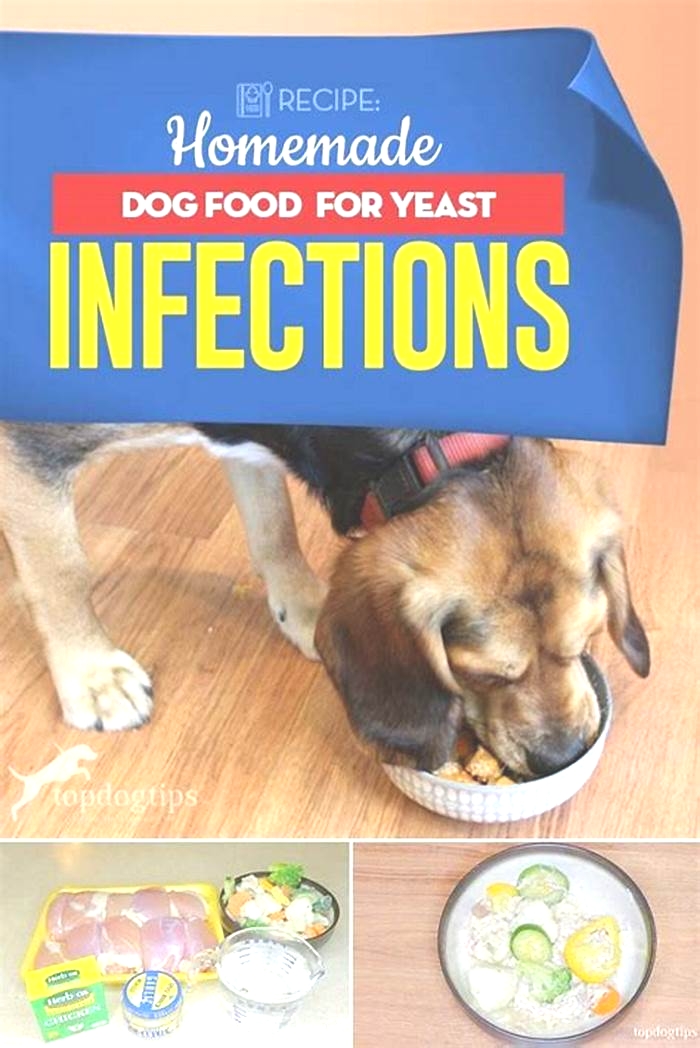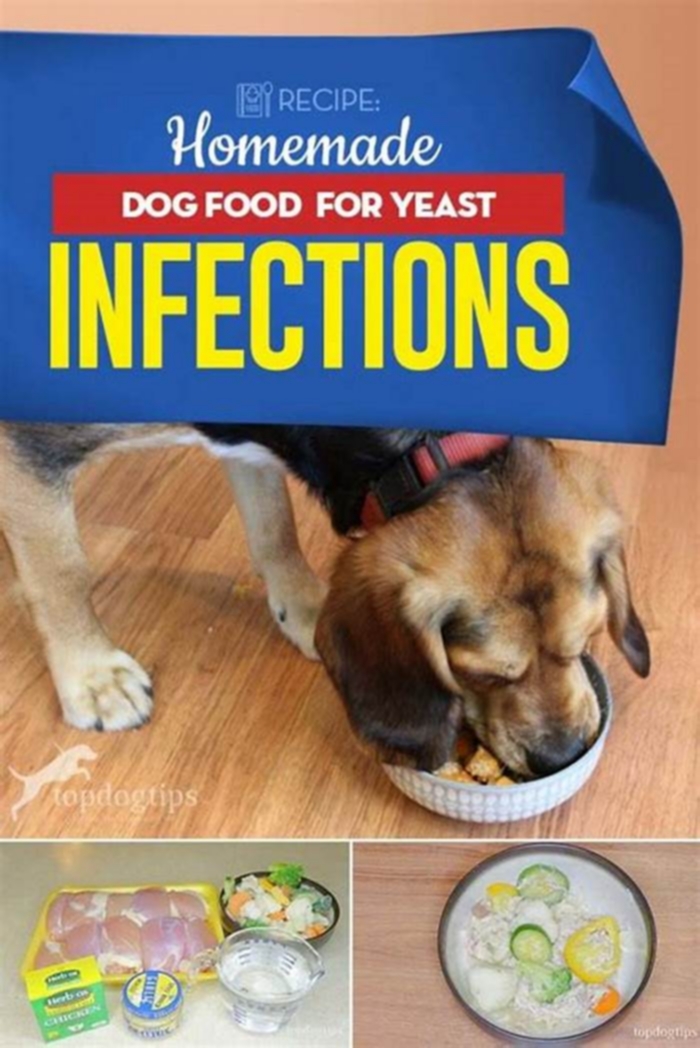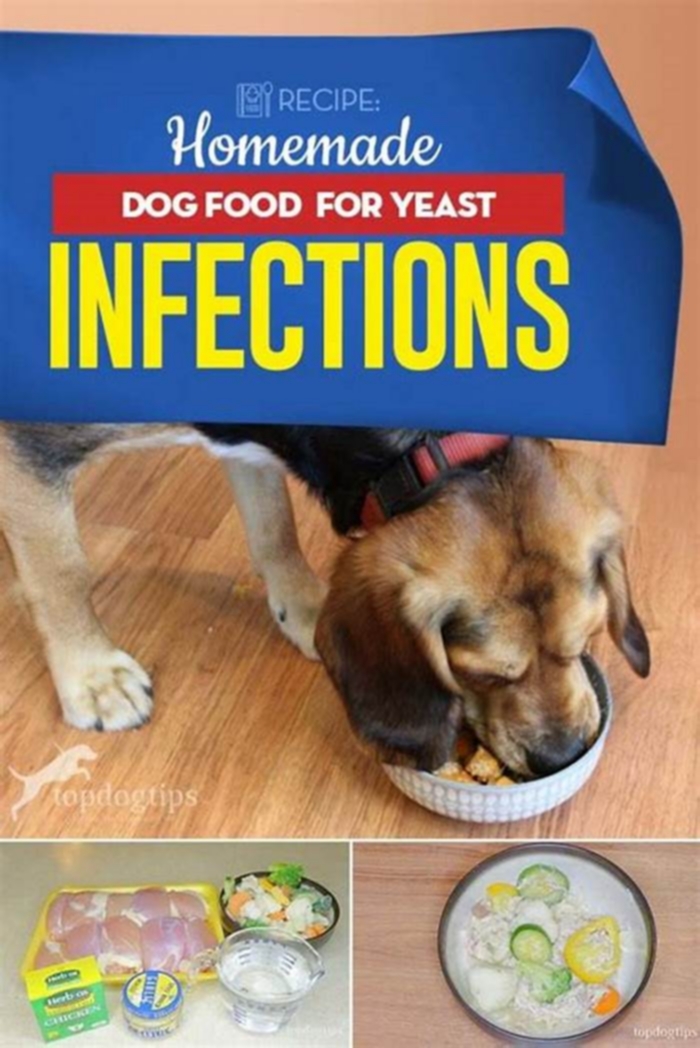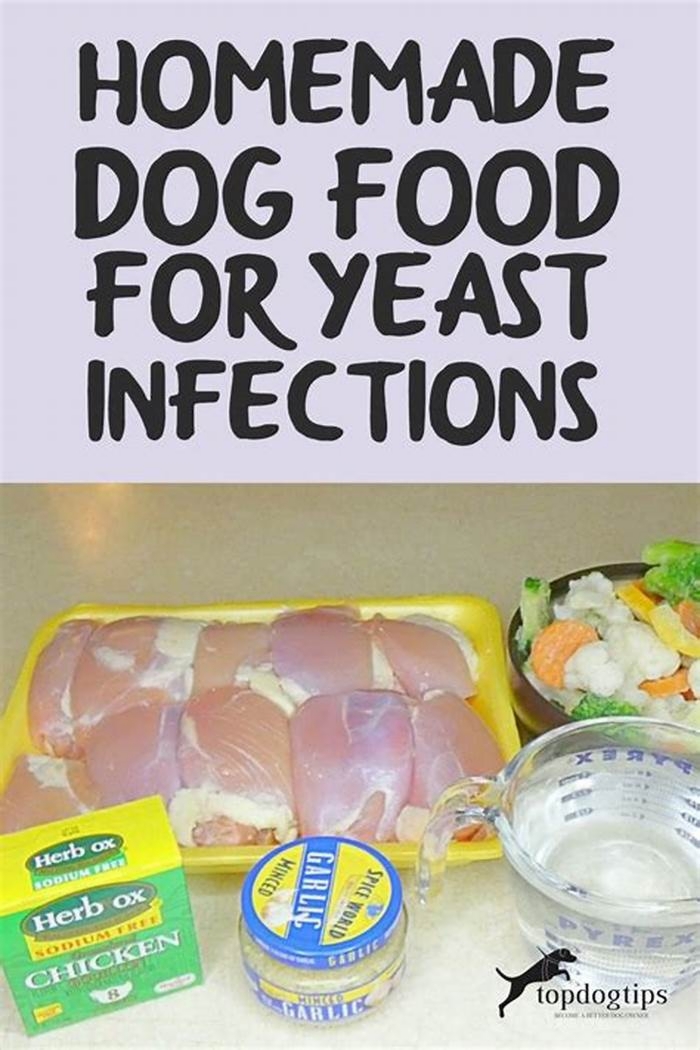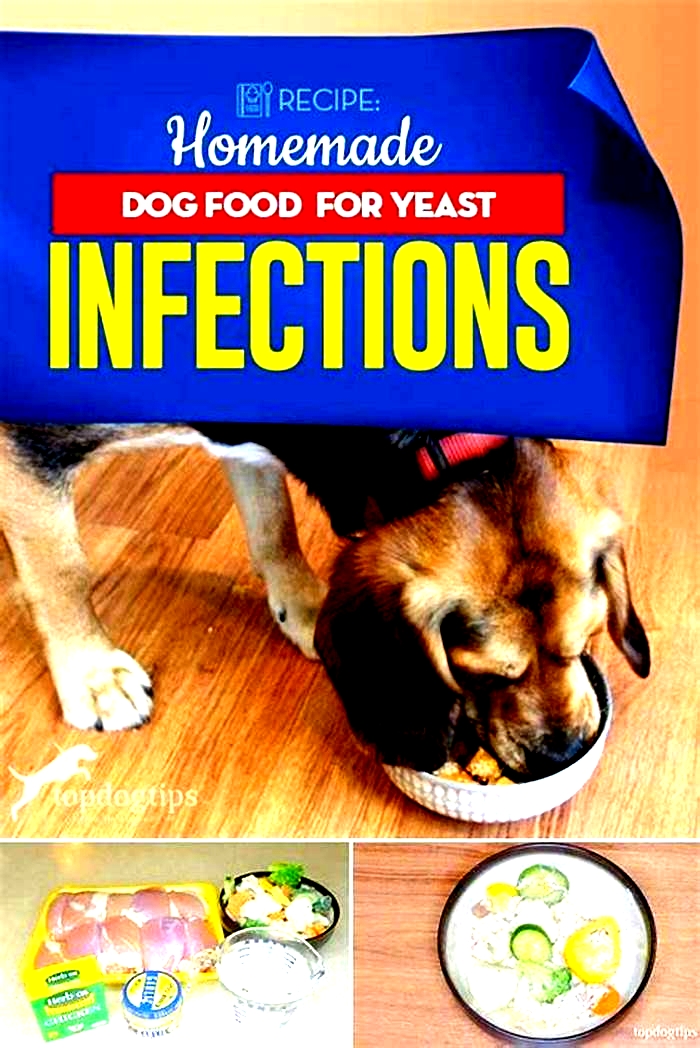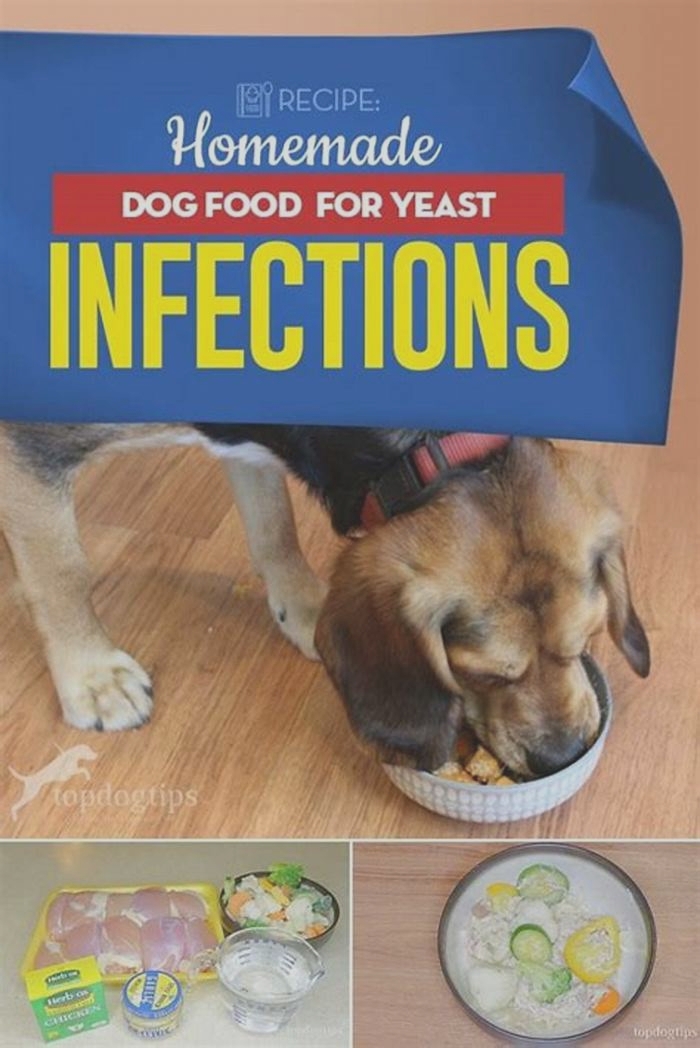homemade dog food for dogs with yeast problems

Recipe: Homemade Dog Food for Yeast Infections
Yeast infections are a fairly common skin condition in dogs.
They are typically not something to worry about, but you should seek veterinary care to get the condition cleared up as soon as possible.
What's a yeast infection all about?
This is a skin infection known as yeast dermatitis where 1 particular type of yeast Malassezialives on your dog's skin all the time.
It does not typically cause problems, except for cases of overpopulation.
So today, I came up with this homemade dog food for yeast infections for your Fidos.
This should help clear up skin conditions associated with an overgrowth of yeast.
Let's get cooking, shall we?
 Dog Food for Yeast Infections: Overview
Dog Food for Yeast Infections: Overview
This homemade dog food for yeast infections is also known as a yeast starvation diet. It will help to treat the infection, and then your dog should be gradually returned to his regular diet.
Note: This diet will not provide balanced nutrition for your dog.
If your dog suffers from chronic yeast infections, consult a canine nutritionist about the best yeast starvation to meet his needs.
This recipe may be a good option for your pet, but a canine nutrition expert will likely recommend supplements and/or a multivitamin.
Homemade Dog Food for Yeast Infections Recipe
 Ingredients
Ingredients
- 3 lbs. boneless, skinless chicken thighs
- 2 chicken bouillon cubes
- 2 cloves garlic
- 1 lb. frozen vegetables
Most experts recommend a diet free of grains, potatoes, and yeast if you're trying to make yeast-starvation dog food.
As you can see, this recipe follows those guidelines. However, there is one ingredient that I am often asked about garlic.

Garlic on Dog Food for Yeast Infections
Most pet owners are under the impression that garlic is toxic to dogs.
This is only true for large quantities of garlic.
In moderation,garlic is actually a very beneficial ingredient for canines.
Foods in the genus Allium, like garlic, onions, and leeks were once considered incredibly dangerous for dogs.
But, according to the Journal of Venomous Animals and Toxins including Tropical Diseases:
garlic, on the other hand, is considered to be less toxic and safe for dogs than onion when used in moderation.
Garlic has natural anti-parasitic, anti-fungal, and antibiotic properties.
As I mentioned, this recipe should not be fed for a long period of time.
It will help to treat the infection, and then your dog should be gradually returned to his regular diet.
Directions
Making this homemade dog food for yeast infections is quite simple.
It's a slow cooker recipe, so it's great if you work outside the home and want to prepare homemade food for your pet.
 Step 1: Add the chicken, garlic, bouillon, and water to your slow cooker.
Step 1: Add the chicken, garlic, bouillon, and water to your slow cooker.
Step 2: Cook on low for 6 hours. If you will be out of the house for more than 6 hours, that's okay. Your slow cooker will automatically shut off or switch to a warm' setting after 6 hours.
Step 3: Add the vegetables and cook on low for another 30 minutes. When the homemade dog food for yeast infections is cooled, you can serve it to your dog.
The recommended serving size is about 1/2 cup for every 20 pounds of body weight. You should feed 2 servings per day.
Keep in mind that exceptionally active dogs will require more calories, while less active dogs may not require as many.
You can store leftovers in the refrigerator in an airtight container for up to 6 days.
Do you want Other Options for Dog Food for Yeast Infection? Follow these Rules and Tips
If your dog is prone to yeast infections, then your vet may suggest an anti-yeast diet.
The above dog food recipes are a good starting point, but you can also get creative as long as you know what to include and what to exclude.
Stick to Raw Food
Giving your dog a raw diet is a good choice if he has regular yeast infections. A raw diet is similar to the meat-based diet of your dog's ancestors.
Most importantly for the yeast infection, there will not be processed carbs that will feed the yeast.
Try a Limited-Ingredient Diet
If you don't want to give your pup a raw diet, you can also look for limited-ingredient commercial food.
Because these foods have fewer ingredients, they tend to have fewer low-quality carbs.
Always Minimize Processed Foods
Even if you don't give your dog a raw diet or homemade food, make sure that you stay away from overly-processed foods.
Some ingredients to avoid include excessive starch, high-fructose corn syrup, and corn fillers.
Avoid Natural Sugars
You don't just want to avoid processed sugars and carbs. Dogs with yeast infections should also avoid natural sugars.
Remember that the glucose in the sugar will feed the yeast.
Go Grain-Free
Because carbohydrates fuel yeast infections, dog owners should also strongly consider a grain-free diet.
Prioritize Protein
When creating your pup's new diet, focus on protein. Remember to focus on unprocessed meats.

Dog Food For Yeast Infections: What to Avoid
Common veterinary advice for dogs with yeast infections includes the following list of foods to avoid:
- Bread
- Bacon
- Peanuts
- Pretzels
- Sausage
- Crackers
- Potatoes
- Buttermilk
- Lunch Meat
- Mushrooms
- Gravy or sauce
- Packaged cereal
- Sweet Potatoes or Yams
- Cheese or cottage cheese
- Anything else with grain or sugar
Dog Food For Yeast Infections: What to Include
You can also get creative with a dog food recipe that has the following ingredients, all of which are good for controlling yeast infections in dogs:
If you opt for homemade dog food, always make sure to plan the recipe carefully so your dog gets all the nutrients he needs.
If you haven't made your pup a meal before, start with dog food recipes to get an idea of the proper balance.
What are the Signs of Yeast Infection in Dogs?
If your dog is scratching his ears nonstop and has cracked lips or red, inflamed skin, it could be a sign that it has a yeast infection.
Chewing of the paws is another sign of a yeast infection in dogs, as the yeast can build up between the toes and cause irritation.
Finally, if the red, itchy skin is accompanied by a foul smell, it's very likely that your dog has a yeast infection.
Home remedies may get rid of a yeast infection in dogs, but your veterinarian can also prescribe a topical cream to help treat the condition quickly.
The Role of Pet Foods in Yeast Infections
The environment is not the only factor influencing whether your dog develops a yeast infection; his diet also plays a role.
To survive and grow, yeast needs energy in the form of glucose.
This glucose comes from carbohydrates and starches.
The problem is that many low-quality foods have low-quality carbohydrates, as they are popular, cheap fillers.
These fillers have minimal nutrition but have all the nutrition that yeast needs.
In other words, a low-quality diet can increase the risk of a skin infection or other types of yeast infections.
Feeding your furry friend anti-yeast dog food is a simple way to overcome this challenge. Watching what your dog eats doesn't have to be overwhelming.
While we offer the above recipe, dog owners with less time on their hands can also find commercial options that are right for your dog's diet.
Common Questions About Homemade Yeast Starvation Dog Food
If you still have some doubts about yeast-free dog food, the following information should answer your lingering questions.
What Do You Feed a Dog with a Yeast Infection?
A raw diet is a very popular option for an anti-yeast diet. You can also opt for a partially raw diet.
If you don't have time to make homemade food, consider a commercial homemade diet.
What Food Kills Yeast in Dogs?
Anti-fungal foods for your dog include items with olive leaf, Pau D-Arco, and caprylic acid.
How Do I Reduce My Dog's Yeast Infection?
If your dog is dealing with yeast infections, your vet will likely suggest yeast-free dog food along with topical treatments.
Examples of topical treatments include antifungal creams, shampoos, sprays, and wipes with ketoconazole, miconazole, or chlorhexidine.
Will Yogurt Help My Dog's Yeast Infection?
Yes, yogurt is a good food to include in an anti-yeast diet. This is because of the probiotics, which can fight yeast infections.
For the best results, choose a natural, probiotic yogurt without added sugar.
Dog Food for Yeast Infections: Before You Go
When your dogs are suffering from illnesses or infections, the best way to alleviate pain is to quickly have them assessed by your vet.
But it just doesn't end there.
Your dogs need your support and aftercare, too.
That's when Top Dog Tips steps in.
Hopefully, this dog food recipe for yeast infections can help you get started.
So, if you enjoyed this blog, you might find the following articles helpful, too!
READ NEXT:
WANT TO SHARE THIS

What To Feed A Dog With Yeast Overgrowth
Food and diet can be a major cause of yeast overgrowth in dogs. So heres some help with what to feed a dog with yeast overgrowth ... plus a recipe for homemade dog food for yeast overgrowth.
First, here are some of the symptoms of yeast overgrowth in your dog.
Symptoms of Yeast Overgrowth in Dogs
Yeast overgrowth is uncomfortable for your dog. Here are some of the signs you might see:
- Head shaking
- Dark rusty-red hair between the toes
- Blackened skin
- Chewing or licking the feet
- Seasonal allergies
- Hair loss on the tail or upper back
If your dog has more than one of these signs, it could be yeast. And theres a way to manage it with homemade dog food for yeast overgrowth.
So heres what to feed when a dog has yeast overgrowth.
Homemade Dog Food Recipe for Yeast Overgrowth
Here's a recipe you can use to help manage your dog's yeast overgrowth.
Ingredients
1 pound lean ground turkey 1/2 pound chicken hearts, chopped1 oz beef liver (1/3 deck of cards), chopped2 eggs without shells1/2 cup chopped kale1/2 cup chopped broccoli2 Tbsp bone meal 2 Tbsp apple cider vinegar2 Tbsp ground pumpkin seeds2 tsp turmeric2 tsp (2 cloves) garlic2 tsp ginger2 tsp MCT oil 1 tsp chlorella1/2 tsp kelp
Add before servingOmega-3 oil (such as fish oil) 1/2 tsp Himalayan pink salt
Directions
Mix up the meat and organs. Add in the vegetables and eggs. Add the rest of the ingredients and mix well. When adding Safe-Sea or fish oil, use 3/4 tsp for a 50-pound dog or the same amount per 1 lb of food.
This makes about 2 lbs of food. Feed a 50 lb dog about 16 oz (1 lb) and adjust according to your dogs weight. The recipe can be doubled or tripled for larger dogs.
Why Feed These Ingredients?
Heres why these ingredients are important in your homemade dog food to help with yeast overgrowth.
- Bone meal: supplies essential minerals and nutrients.
- Kale &broccoli: great sources of antioxidants that also support the immune system.
- ACV: can help support the normal detoxification of yeast.
- Pumpkin seeds: a natural source of vitamin E (and theyre also a great solution for intestinal worms).
- Turmeric: can help support the normal detoxifcation of yeast.
- Garlic: supports a healthy liver and gut function, which is important for yeast die-off.
- Ginger: support gut health and liver function.
- MCT oil: contains caprylic acid that helps support the normal detoxification of yeast.
- Chlorella:supports the body from exposure to heavy metal or environmental toxins.
- Kelp: rich in iodine. Yeast can be linked to hypothyroidism and iodine can help balance the thyroid gland.
Other Foods to Include in Homemade Dog Food
There are other foods and vegetables that you can include to increase the level of antioxidants for your dog, like leafy greens or asparagus. If you give fruit, useberries, blackberries and raspberries that are lower in sugar and offer exceptional health benefits.
RELATED:Antioxidants for dogs
Foods to Avoid for Yeast Overgrowthin Dogs
Avoid starchy vegetables, foods that contain carbohydrates and added sugars that may show on labelsas dextrose and fructose. They include:
- Carrots, parsnips, peppers (which are also a nightshade vegetable that you should avoid because it contains solanine, which may further aggravate inflammation).
- Potatoes
- Sweet potatoes
- Squash including pumpkin
- Tapioca
- Grains like rice, millet, wheat, corn and oats
- Starchy vegetables like carrots, parsnips and peas
- Legumeslike lentils, chickpeas, lima and kidney beans
- Dairy, including yogurt
Note:Youll often see yogurt recommended for yeast infections in dogs. But dairy, including yogurt, contains natural sugar that will continue to feed the yeast. Instead of yogurt, its best to give a probiotic supplement. Then youll know youre giving enough CFUs (colony forming units) to address problems like digestive issues or diarrhea.
The Best Supplements for Dogs With Yeast Overgrowth
Here are some of the best foodsand herbs for dogs with yeast overgrowth.
Caprylic Acid MCT oil is the best source of caprylic acid. Start slowly and work your way up to avoid diarrhea until your dog adjusts to it. Medium to large dogs should start at tsp.
Olive Leaf Olive leaf powder contains oleuropein. Many studies show it can help with the normal detoxification of yeast. Give small dogs 1/4 tsp, medium 1/2 tsp and large 1 tsp daily, but again, start slowly.
Pau DArco Pau darco comes from a tree native to the Amazon. A potent powerful, it can help with yeast overgrowth. Choose pau darcoin a dried herb thats standardized and high quality. Give small dogs 200 mg twice daily, medium 300 mg and large 400 mg.
Caution:Dont give pau darco to pregnant dogs.
Goldenseal Studies show that goldenseal can help with yeast overgrowth. It containsberberine, a protective alkaloid.Choose dried goldenseal or goldenseal tincture. For powder, give 1 tsp per 20 lbs of body weight, or 510 drops of tincture per 20 lbs, 1-2 times daily. .
Caution:Dont use goldenseal long term and avoid it with pregnant or hypoglycemic dogs.
Yeast overgrowth is uncomfortable for your dog. When you improve his diet, you begin building better health for him,from the inside out.

